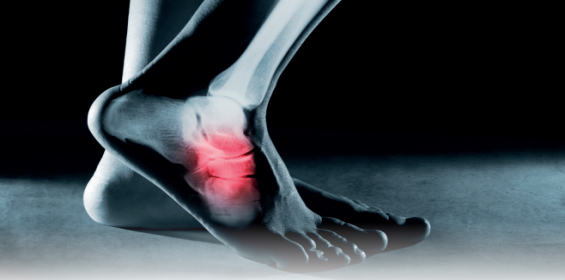Six steps to happier feet in the workplace
Published: 05 January, 2023
Alex Minett, Head of Products & Markets at CHAS, looks at what employers and employees need to consider to protect feet at work.
You could say that feet are one of the most hard-working yet, most neglected parts of our bodies. We take it for granted that they will keep us upright, balanced and mobile. Yet, we only ever seem to pay them attention when something goes wrong. As always, prevention is better than cure, and there are many ways we can help ensure we put our best feet forward when it comes to foot health.
1. Familiarise yourself with foot injuries
Feet are susceptible to all sorts of injuries, and even relatively minor conditions can cause significant suffering and impair our ability to work. Common injuries to the feet include fractures, sprains, punctures or cuts and lacerations. In some workplaces, chemical or thermal burns are also possible, along with issues associated with working in extreme weather, such as frostbite. Conditions such as blisters, bunions, fungal infections, fallen arches and plantar fasciitis are often more debilitating than you think and can lead to chronic issues if not prevented or treated correctly.
2. Identify workplace hazards
Uneven surfaces, obstacles, trailing cables, wet or slippery surfaces and changes in levels can result in slips, trips & falls. Upturned nails and other sharp objects can cause puncture wounds, and in workplaces where chemicals are in use, the risk of burns from spillages increases. Feet are also vulnerable to cuts and lacerations from machinery and power tools, while unstable, heavy objects may cause crushing injuries. Prolonged standing can result in foot conditions such as varicose veins, swelling, bunions and fallen arches. Meanwhile, standing for long periods directly on hard surfaces, such as concrete, can cause plantar fasciitis.
3. Select the right safety footwear
Where a risk cannot be eliminated, substituted or workers isolated away from the hazard then safety footwear is likely to be required. Any environment where there is a risk of slipping requires anti-slip shoes, where there is a risk of standing on sharp objects, then puncture-resistant soles are needed, and safety footwear is always needed where feet could be crushed or caught in machinery. According to ISO 20345:2021 the basic requirement for protective footwear is that it comes with steel-toe caps that can withstand 200 joules of impact. These come with the abbreviation SB, meaning Safety Basic. However, all safety footwear comes rated at different safety levels ranging from S1 to S5, incorporating a myriad of protective factors including oil resistance, penetration resistance, energy absorption, resistance to water penetration, anti-static, heat resistance and insulation and, cold insulation. Your safety footwear supplier should be able to advise you on the most appropriate safety footwear.
4. Get the fit right
For all footwear, safety or not, it’s vital to get the correct fit. There should be enough room at the front for wiggle room with around 1cm space between the longest toe and front of the shoe. Take some time to walk around in new footwear to make sure they are comfortable. The heel should fit comfortably and securely and not slip out of the shoe. According to advice from National Feet Week, which took place earlier this year, when it comes to fastening, shoe lacing can greatly impact the way shoes fit according to different conditions. Those with a wide foot/high instep will benefit from lacing shoes using the eyelets closest to the tongue and by employing the under and over tying technique if more room is needed. Narrow feet should lace through the eyelets furthest from the tongue to ensure a tighter fit. Always see a podiatrist for expert advice and guidance if you have issues with your feet that may need further investigation or extra help with orthotic devices.
5. Don’t forget the weather The great British weather has an impact on our feet, especially for outdoor workers. Cold conditions without adequate thermal protection can lead to frostbite, where blood flow is directed away from extremities to protect the body’s primary organs resulting in a risk of tissue damage to toes. Chilblains are often associated with the cold and can make feet itchy, sore and very uncomfortable, while trench foot, also known as nonfreezing cold injury (NFCI) is another serious condition that can affect feet. Unlike frostbite, trench foot occurs when feet have been exposed to wet as well as cold conditions for too long leading to loss of blood circulation and nerve damage. If left untreated, feet can become gangrenous.
Feet can also struggle in hot temperatures, with the risk of swelling and foot fatigue leaving feet tired and achy. Excessive sweating creates the perfect environment for blisters and fungal conditions such as athletes foot. Ensuring feet are washed and dried at the start and end of every day and wearing socks with moisture-wicking properties will help with foot hygiene and comfort during hot spells.
6. Keep your feet fit
The Society of Shoe Fitters advocates a number of tips to keep feet fit and healthy. Preventing infection is best achieved by regular washing and drying, and nails should be cut straight across in order to avoid ingrown nails. In terms of exercise, use your feet to pick up objects from the floor – anything from marbles to items of clothing. Next, regularly wiggle your toes, separating them one by one and lastly, while sitting or lying comfortably, follow a circular motion with your foot both clockwise and anti-clockwise. All these exercises will help relax and strengthen weary muscles.
Conclusion
Don’t let foot injuries become your Achille’s heel when it comes to health and safety. Regular risk assessments, ensuring workplaces are safe and free from hazards, along with the provision of appropriate PPE, training and workplace signage to remind workers of the risks, will all pay dividends in protecting these often-forgotten parts of the body.
https://twitter.com/chas2013ltd
https://www.linkedin.com/company/chas2013ltd/







